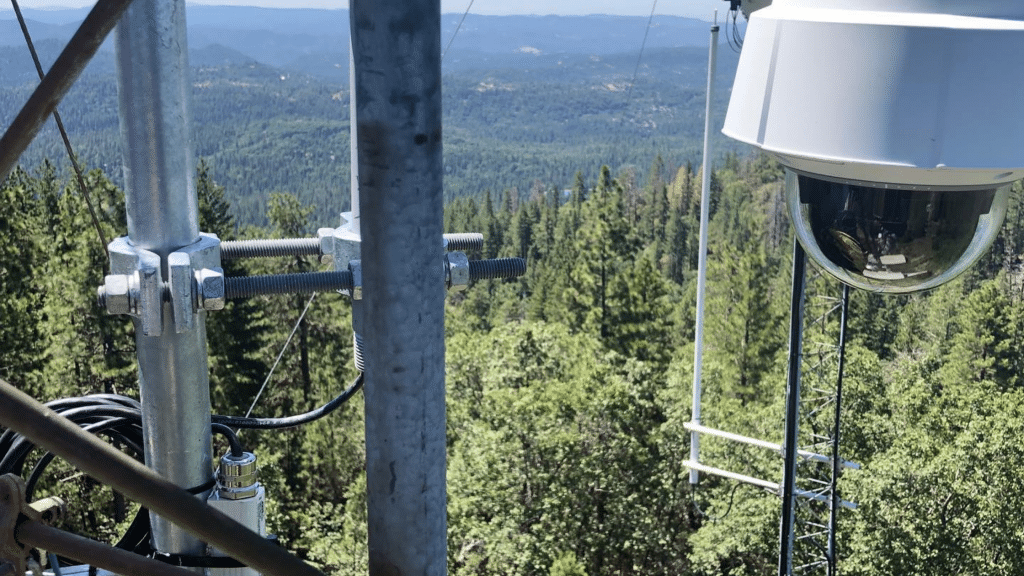Conifer Communications plays a vital role with the ALERT California program by providing sites and internet services to the California Central Sierras.
What is ALERT California?



The ALERT California consortium comprises three universities: the University of Nevada, the University of California at San Diego, and the University of Oregon. Its goal is to provide public access to cameras that can tilt, pan out and zoom in. The video camera views of this partnership are intended to help fire agencies find fires, monitor the behavior of fires, and assign emergency resources. The ALERT California Program has steadily expanded across the western United States.
Who is Behind the ALERT California program?
Led by Dr. Graham Kent of the University of Nevada, Reno, there is a dedicated team of men and women who work on the ALERT California program behind the scenes at universities across the west: Dr. Ken Smith of the University of Nevada Reno, Dr. Neal Driscoll, of the University of California-San Diego and Dr. Doug Toomey of the University of Oregon. </span
This initiative, which uses thermal cameras to detect wildfires from an early stage, has been funded by settlements from electric utility companies, federal and state grants, donations of equipment, and funds by businesses such as Conifer Communications.
More about the ALERT California Program
With over 700 cameras in service across California, Nevada, Oregon, Washington, Idaho, and Utah, the network provides fire cameras and tools to help firefighters and first responders to:
- Discover, locate, and confirm fire ignition.
- Quickly scale fire resources up or down.
- Monitor fire behavior during containment.
- Help evacuations through enhanced situational awareness.
- Observe contained fires for flare-ups.
[use the video on the beta site: http://alertca.live.]
These cameras are critical for mountain top asset protection. It gives CalFIRE, BLM, and USFS those needed eyes to protect assets.
Each camera has the ability to tilt, pan out and zoom in. They also use near-infrared “sight” to allow for the detection of fires at night. When a spark is found, the team triangulates its position using one or multiple cameras and mapping out its relative distance from the fire site. This allows first responders to know where the fire is and the best way to attack it without having to guess which road will be the best access route.
How Conifer Partners with ALERT California

Conifer Communications is a critical partner with the ALERT California program by providing sites and internet connections in the California Central Sierras. We support about 30 cameras within Amador, Calaveras, Tuolumne, and Mariposa Counties. We do this by installing the cameras on our internet service towers. We monitor the power they receive and the quality of their internet connection and make sure to keep up and live even through Public Power Safety Shutoff events. While we do not have control over where the cameras are pointed (that is the job of the operations team of ALERT California, CalOES, and CalFire), we do ensure that the cameras are blocked from viewing or recording any private property near the cameras to keep all our neighbors and customers safe.
The ALERT California cameras in our local community have been critical in pinpointing the location of fires and helping first responders stop the fires. As the cameras are available to the public, they allow local residence more information about fires in their area. This has given many people an early warning when needing to prepare for evacuation. It has also provided some peace of mind when they are out of the area, but they can see that the fire is not on their property.
How ALERT California Helps Communities

Sometimes the way to understand how beneficial a program can be is to hear it directly from those it has helped. These testimonials and video footage show how ALERT California has helped to prevent the growth of 1000s of wildfires:


Stopped Arson near Emerald Fire near Lake Tahoe
1:45 minutes later, an arsonist uses Emerald Fire to try and sneak a fire into a neighborhood at South Tahoe in 60 MPH winds. Early discovery/situational awareness, fire is knocked down.
How you can Participate in the ALERT California Program

The ALERT California program is an innovative partnership between local Internet Service Providers and counties to allow for equipment and cameras to be mounted on public towers. These are strategically placed high-powered, panoramic cameras that can see fires from a distance as well as any other activity in the area, including weather conditions such as lightning strikes. The site provides live streams of these views, so you can check them out anytime if you’re concerned about your safety or want to know what’s going on with wildfires near where you live. You can also report fires yourself by clicking through the links at http://alertca.live/.

Conifer Communications
Rural High Speed Internet Provider with Unlimited Data








